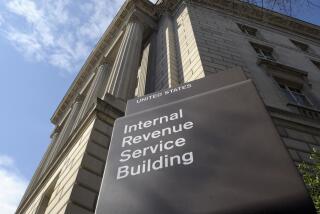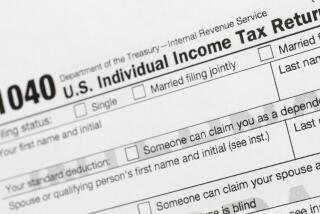IRS releases rules on 20% tax break for pass-through business owners

Business owners — and their accountants — can rest a bit easier: The Internal Revenue Service has provided the long-anticipated final word on how they can claim one of the biggest perks in the 2017 Republican tax overhaul.
The regulations detailing the new 20% deduction for pass-through business owners are of crucial importance to the operators of such entities, who range from mom-and-pop convenience store owners to private equity investors.
The guidance, issued Friday despite an ongoing partial government shutdown that has many IRS employees on furlough, can cut those business owners’ tax bills by as much as one-fifth. The rules would govern what many say is one of the most complex changes in the tax law President Trump championed.
The IRS made a series of changes to make it simpler for businesses to determine whether they can get the tax break, a senior Treasury official said on a call with reporters.
Veterinarians, for example, don’t qualify for the deduction, but rental real estate owners who spend at least 250 hours a year involved with the business can get the deduction, according to the IRS guidance.
The rules make clear that income from originating and selling mortgages is eligible for the deduction, said Alan Keller, first vice president of legislative policy at Independent Community Bankers of America, a trade and lobbying group. “That is favorable,” he said.
Filing season awaits
Taxpayers had been worried that because of the partial shutdown of the federal government they wouldn’t see final rules before the Jan. 28 start of tax-filing season, and that confusing parts of the original provision could leave them exposed to penalties plus interest on improperly reported income.
Even if the shutdown ends today, the IRS may not issue you a timely tax refund »
On Friday, the IRS also released a proposal clarifying that shareholders of mutual funds with real estate investment trust investments can get the deduction. That change will affect about 15 million investors, according to a trade group representing REITs. The IRS is still considering whether publicly traded partnership investments held through a mutual fund will qualify for the deduction.
The proposed regulations also provide guidance for taxpayers who hold interests in regulated investment companies, charitable remainder trusts and split-interest trusts, the IRS said in a statement.
The agency also put in a test for rental real estate owners to know whether they can get the tax break: The answer is yes if the property owners — or someone they hire, such as a contractor — spend at least 250 hours a year on the business and keep records of their activities.
Small businesses
The pass-through deduction was included in the overhaul to give a tax break to businesses whose owners pay the taxes on their personal tax returns — partnerships, limited liability companies and S corporations. Trump and Republican leaders have said that middle-class Americans and small businesses would be the biggest beneficiaries under the $1.5-trillion tax cut.
All taxpayers who earn less than $157,500, or $315,000 for a married couple, can deduct 20% of the income they receive via pass-through businesses from their overall taxable income. If taxpayers earn above those amounts and aren’t service professionals — such as lawyers or accountants; they must meet certain tests to take the full deduction — the size of their deduction depends on how much they pay in employee wages or how much they’ve invested in capital such as real estate.
For service professionals, the break fully phases out if they earn more than $207,500 if they’re single or $415,000 if they’re married.
No ‘crack and pack’
The rules make clear that companies can’t use a tax planning technique called “crack and pack” to avoid limits on the new tax break. Professional service providers had eyed the break to get around the income limits set for owners of pass-through businesses.
By using the strategy, they could have split their firms into different entities to lower their tax bills. For example, a law firm could have put all of its secretarial staff into one entity and its lawyers into another to get the full deduction on the income tied to the administrative work. That’s not allowed.
But companies with some income that qualifies and some that doesn’t can still delineate those different activities, such as through separate accounting books, to get the deduction on the eligible income. For example, banking activities qualify for the deduction but wealth management advising doesn’t, so a bank with some investment advising can separate the bookkeeping for those two units and still get the deduction on the qualifying income.
Simpler record-keeping
The deduction is limited for employers who pay low wages or hire few workers. But the rules make it easier for related pass-through businesses to maximize their deduction by allowing companies to combine at the entity level or at the owner level. For example, two related businesses — one with a lot of employees but little profit, and another with a lot of profit but few wages — could aggregate their payroll and income to get a bigger tax break.
The rules retain a provision meant to simplify record-keeping if companies have only a small amount of income from ineligible activities, such as health or law. If less than 10% of the income is from ineligible sources, the company can still get the full deduction on all its profits.
‘Anomalous results’
Despite Treasury rules making it more clear how the law is implemented, the deduction isn’t available evenly, even within industries, said Mike Greenwald, a partner at accounting firm Friedman LLP. A longtime building owner may not be able to get the tax break, while newer buyers might be able to get the deduction because they have invested more capital in the building, he said.
“We’re seeing a lot of anomalous results,” said Greenwald.
Donald Susswein, a pass-through tax specialist who’s a principal in the Washington National Tax unit of RSM US LLP, said the final rules allow taxpayers to choose whether to use prior proposed regulations or the final regulations when preparing their returns.
Ordinarily, final rules supersede earlier rules, but this time the Treasury Department made an exception because many taxpayers had already put their accountants to work for the filing season. “It’s unusual,” he said.
One thing the final rules didn’t clarify, Susswein said, concerns taxpayers with multiple trades and businesses held within the same entity.
For example, he said it’s not clear how much of a deduction would be available to an optometrist who sees patients, which is a service business subject to the cap, and also grinds lenses, which is a manufacturing business not subject to the cap.
Howard Wagner, a national tax services partner at Crowe LLP, said the final rules deal a blow to real estate owners involved in a popular type of lease known as a triple net lease. The term refers to property owners who lease a building to an investor but require the investor to pay for repairs and maintenance. Those property owners aren’t eligible for the deduction, he said.
Want to cut your tax bill? Keep reading and then call your CPA »
Davison and Browning write for Bloomberg.






